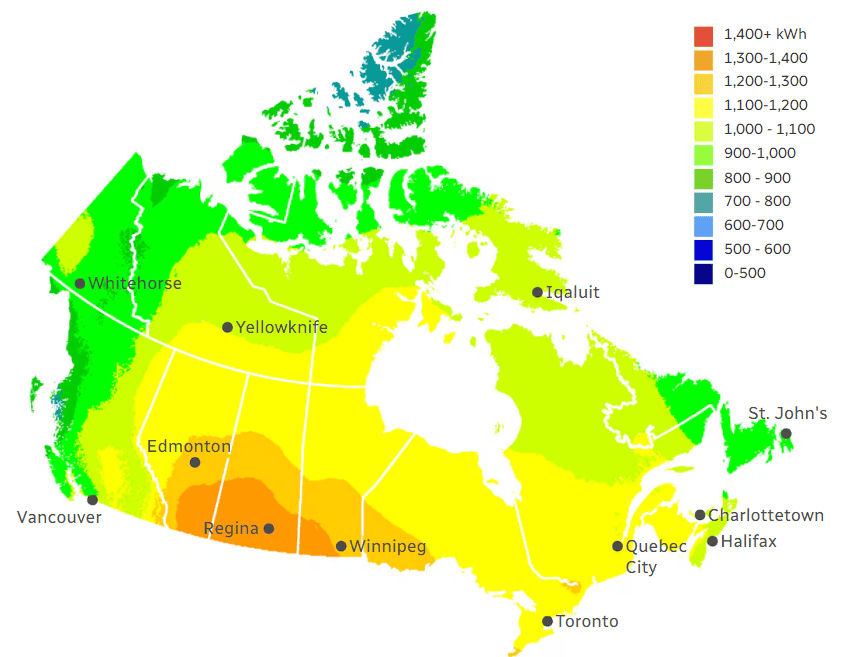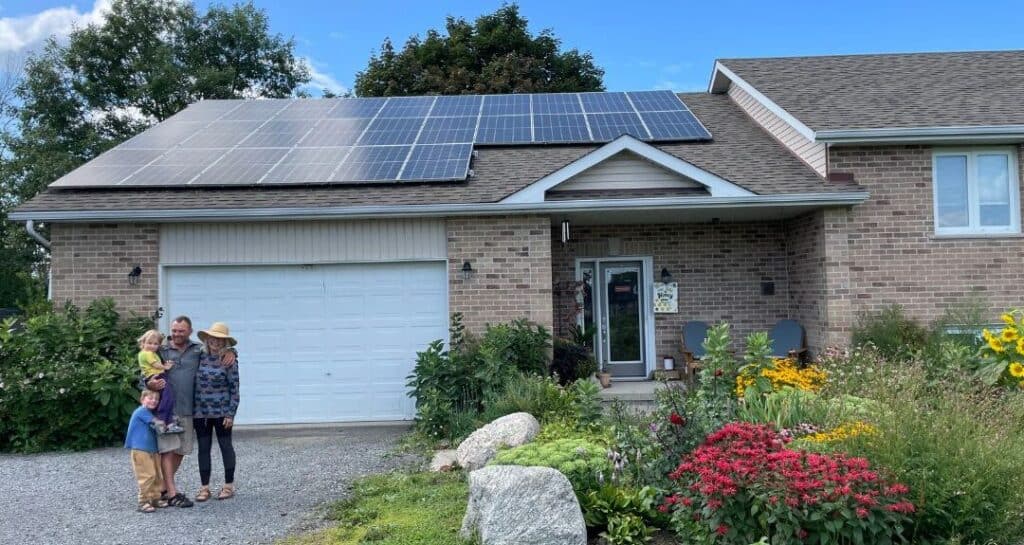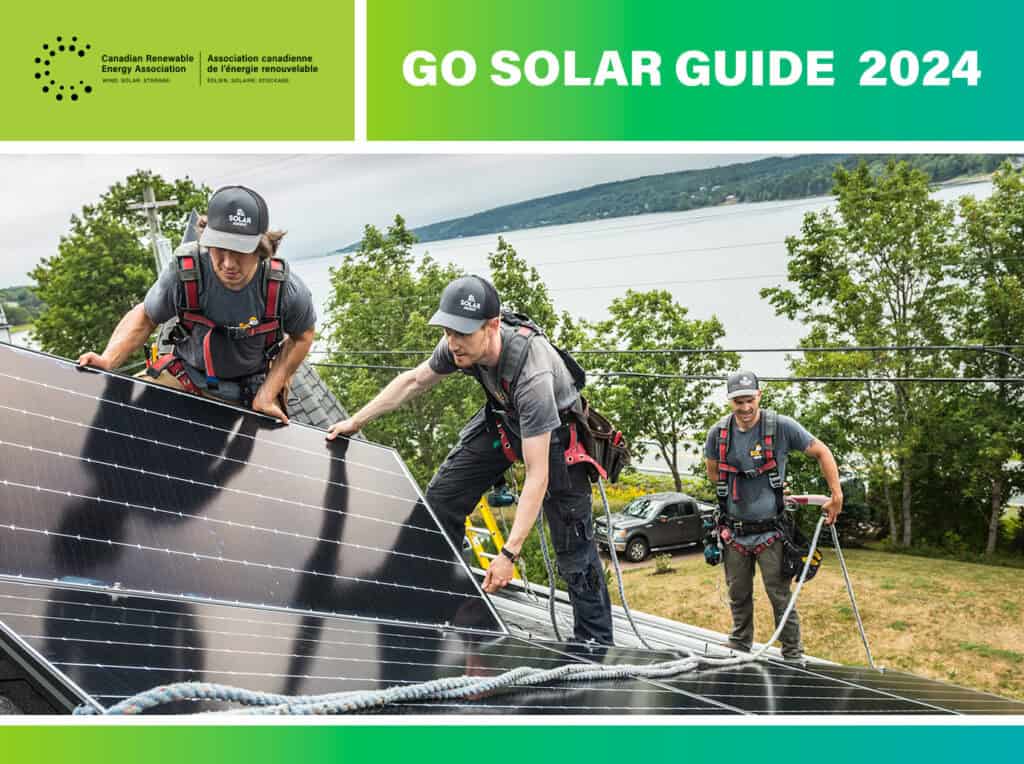
After you have first air sealed and insulated your home.
And second downsized and electrified your heating and hot water.
Solar makes sense in most places in Canada.
Residential solar is especially beneficial for the climate in provinces where it displaces electricity generated from fossil fuels, such as Alberta and Saskatchewan, which also happen to be the sunniest.
Even in the north there are significant seasonal benefits to solar especially in places where electricity is generated by diesel.
And rooftop solar could—technically, and with lots of caveats—supply 100% of the electricity consumed in Canada’s residential buildings concludes a technical report from CanmetENERGY.
Whether residential solar will save a homeowner money largely depends on which province or territory the home is located in, but also depends on whether the home has a smart meter or not. This is because electricity prices vary a lot across the country, meaning residential solar is competitive in some provinces and territories and not in others.
The cost to install solar has fallen significantly in Canada over the past five years. Meanwhile, costs should continue falling and what isn’t financially viable today might be in the future.
“I’m an accountant,” she said, “and when you do the math … financially it makes sense to have solar on your house.”
Homeowner Ashley Reid excerpt from CBC

Retrofitting Your Home with Solar Panels
There has never been a better time to harness the power of the sun!

Today, more Canadian homeowners than ever before are installing solar, and with the cost of the technology having fallen by more than 80% since 2010, it’s easy to see why.
In addition to the environmental benefits of solar, generating your own energy from the sun through solar photovoltaics (PV) saves you money on your electricity bills and, when paired with storage, can help ensure your home is prepared in the event of a power outage or natural disaster.
There are many advantages when consumers generate their own solar energy on-site:
- Increased energy independence for individuals
- Savings for households and businesses, because less electricity needs to be purchased from the grid
- Lower overall costs for the electricity system, by helping to avoid the need for new utility-scale electricity generation, transmission and distribution infrastructure
Learn how to make your home Solar Ready with these guidelines from Natural Resources Canada.
Solar Water Heater
Solar water heaters provide you with several benefits over conventional water heaters.

You will reduce your hot water heating costs.
You will also be directly reducing greenhouse gas emissions (carbon dioxide, CO2, released into the atmosphere), thereby contributing to a healthier environment.
Most solar water heaters consist of solar collectors mounted on the roof of a house; a pump for circulating the heat transfer fluid; a heat exchanger for transferring the heat to storage; and one or two storage tanks for storing solar-heated water for periods when there is no sun.
Learn more from Solar Water Heaters – Buyer’s Guide by Natural Resources Canada

Start your deep energy retrofit today.
Save energy. Make your home more comfortable.
Have less maintenance. Keep more money in your pocket.
Glossary
Inverter: A solar power system generates direct current (DC) electricity, yet homes and businesses use alternating current (AC) electricity to power electronic devices. A solar inverter takes the DC electricity from the solar system and uses it to create AC electricity. Inverters are like the brains of the solar system. Along with converting DC to AC power, they also provide ground fault protection and system stats including voltage and current on AC and DC circuits and energy production.
Net metering – When a grid-tied solar system produces more energy than is needed, the excess power is sent to the electrical grid to be redistributed where it’s needed. This is called “back feeding” the grid. At night, the grid will provide conventionally created power for the solar customer’s use. A net meter records the energy sent compared to the energy received from the grid and credits or charges the user according to local rates and rules. Forty-four states currently offer net metering or some variation of it.
Photovoltaic (PV): PV technologies convert sunlight to electricity through a naturally occurring process in certain types of material, which are called semiconductors. When photons (energy particles) from the sun hit semiconducting materials such as silicon, electrons are knocked free from their atoms. If conductors are attached to the positive and negative sides of a solar cell, it forms an electrical circuit. When electrons flow through such a circuit, they generate electricity, powering electrical devices or sending electricity to the grid.
Renewable energy: Energy generated from sources that naturally continually renew themselves, such as sunlight, wind, geothermal heat or tidal movement.
Solar Array: Photovoltaic modules are connected together into panels and arrays to meet various energy needs. The solar array is connected to an inverter that converts the Direct Current (DC) generated by the PV array into Alternating Current (AC) compatible with the electricity supplied from the grid. AC output from the inverter is connected to the home’s electrical panel or utility meter, depending on the configuration.
Solar panel efficiency: The percentage of sunlight that solar panels can convert to electricity. The first solar panels had about 6 percent efficiency. SunPower solar panels have the world record for efficiency of commercially available panels — 22.8 percent1, but a panel we recently developed in the lab was verified at 24.1 percent efficiency 2. Solar panel efficiency matters because high-efficiency panels can generate more power in less space over time than conventional panels, so you need fewer panels to get a higher return on your investment.
Solar photovoltaic (PV) system: A system that directly converts sunlight into electricity. When light energy strikes the surface of a photovoltaic device, a direct current is created.
Solar Thermal: Solar thermal technologies (also known as panel panel-default solar systems) involve the conversion of solar radiation into heat and include the use of pumps or fans to panel panel-defaultly transfer the heat to storage or for distribution directly to its intended use. The key component of any panel panel-default solar system is the solar collector, which absorbs the sun’s radiant energy and transforms it into usable heat.
Various types of collectors are used in solar energy conversion, depending on the application and temperature requirements:
- Unglazed metal and plastic flat plate collectors are used for low temperature applications such as residential pool heating and ventilation air heating for commercial and industrial buildings
- Glazed flat plate and vacuum tube collectors are used for mid-range temperature applications such as domestic hot water and space heating and cooling applications
- Concentrating collectors that focus the sunlight onto a much smaller area are used for higher temperature applications such as industrial process heat, absorption cooling, and large-scale solar thermal power applications to generate steam for electricity generation